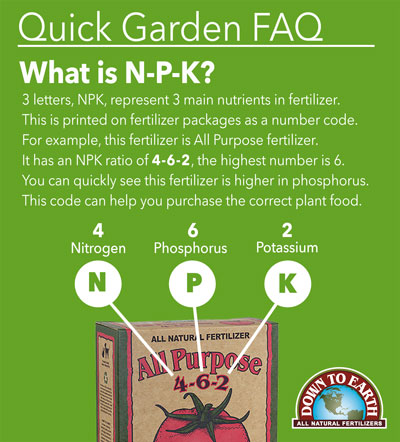HOW TO USE ORGANIC FERTILIZER

What are Organic Fertilizers?
Organic Fertilizers are derived from all-natural plant, animal or mineral resources, and may be combined with organic matter.
This type of fertilizer is ideal for enhancing soil fertility and stimulating plant growth in a sustainable and environmentally friendly way.
Organic fertilizers add nutrients to the soil for uptake by plants. These nutrients are also used by the myriad of microorganisms that inhabit healthy, productive soil, which in turn benefit plant growth.
Natural and Organic Fertilizer helps strengthen soil health and is an eco-friendly alternative to chemical fertilizer and soil amendments.
Fertilizers are generally available in several different styles, for example, dry, powdered, granular and liquid.
Fertilizer packaging options include bags, boxes, buckets, and jugs.
Single-ingredient fertilizers, such as Down To Earth Alfalfa Meal, or Kelp Meal, may be used to correct deficiencies or target a single plant growth requirement, while fertilizer blends, such as Down To Earth Rose & Flower Mix, or Tree & Shrub Mix 4-2-4, are convenient multi-purpose mixes. These are professionally blended fertilizer formulas of different nutrients, designed for ease of use in multiple applications.

WHAT IS N-P-K?
Click here to watch this 60 second animation to fully understand
what N-P-K stands for, on fertilizer packaging.
Understanding the NPK Ratio
Fertilizers are labeled with numbers that represent the percentage of the three primary macronutrients (Nitrogen (N), Phosphorus (P) and Potassium (K) that are immediately available in the fertilizer.
These elements are listed as the NPK ratio.
For example, our All-Purpose Mix 4-6-2 is comprised of each primary nutrient, whereas our
Blood Meal 12-0-0 has a "12" meaning 12(N) - 0(P)- 0 (K) therefore, this is a single ingredient source of nitrogen. Each nutrient plays specific and complementary roles.
Nitrogen (N) energizes vegetative growth,
Phosphorus (P) produces expansive roots, flowers, fruits, and viable seeds, while
Potassium (K) (or potash) promotes resistance to disease and temperature stress. Most fertilizers will also contain varying amounts of the secondary macronutrients – calcium, sulfur, and magnesium – along with trace elements or micronutrients that also play essential roles in plant nutrition.
To someone accustomed to the higher NPK ratios of chemical fertilizers, such as 18-51-20, the modest amounts that occur in organic fertilizers may appear inadequate. However, nothing could be further from the truth; organics simply break down at a slower rate.
Nitrogen supplying organic fertilizers contain insoluble nitrogen that releases slowly with greater effectiveness than conventional fertilizer, thus reducing the need to re-apply fertilizers as often in order to maintain soil fertility. Using natural and organic fertilizer helps to minimize the possibility of “burning” plants, which can happen when using concentrated chemical supplies of nutrients. Natural and organic fertilizer helps to improve overall soil health rather than degrade it by encouraging microbial life in the soil to flourish. Since organic fertilizers last longer and release their nutrients slowly, the long-term NPK amounts will be greater and more beneficial than what is shown on the label.
Single-ingredient fertilizers are used for specific plant needs and in certain stages of a plant’s development. For example, a high nitrogen source like Feather Meal 12-0-0 is used when heavy feeding plants such as corn need an additional boost early in the season.
To promote big, beautiful blooms on your flowering plants, utilize a high phosphorus fertilizer, such as Guano. For Example, our Island Phosphate 1-11-0 or Bat Guano 7-3-1.
Blended fertilizers (Mixes), on the other hand, are used for more general needs around the home and garden. Our All-Purpose Mix 4-6-2 is ideal for vegetables, flowers, and trees as well as house plants.
A great advantage of multipurpose blends is that they save gardeners time and labor by offering a variety of single ingredients pre-mixed in exact and balanced proportions.
THE VARIOUS FERTILIZER STYLES
Single Ingredients, Blends (Mixes), Liquids and Wettable (Soluble) Powders
Organic Fertilizers are sold in three main styles or forms: dry, water-soluble powder, and liquid.
Dry Fertilizers come in several textures: pulverized powder, granulated and pelletized (prilled). They can be broadcast or spread over garden soils and lawns, and also incorporated into potting soils prior to planting to provide nutrients to transplants and new plants. Dry organic fertilizers generally meet plant needs by releasing their nutrients slowly over time in a steady supply.
Wettable Powders / Soluble Powder Fertilizers begin to break down immediately so they can be applied to the top few 12 inches of soil for quick release, or transformed into liquid fertilizer for foliar feeding or for use in irrigation systems. A foliar tea can be made by soaking the fertilizer powder overnight in a cloth bag suspended in a container of water. In the morning, empty the residue that is left in the bag around your garden, and pour or spray the richly colored liquid on garden plants.
Liquid Fertilizers usually come as a concentrate and need to be diluted with water before using in your garden or to feed your houseplants. Both teas and dilutions can be applied with watering cans, hose-end sprayers, or through irrigation systems in a method known as fertigation. Tea and liquid soil feedings work best after a light rain or regular watering when the soil is more absorbent. Teas and liquids can also be applied directly to the leaves and bark of plants and trees using the above mentioned foliar feeding methods.
Foliar Sprays are several times more effective as a method of fertilizing than soil applications in correcting nutritional deficiencies and stress-related problems under some conditions.
For best results, spray early in the morning and when the air temperature is below 85° F.

